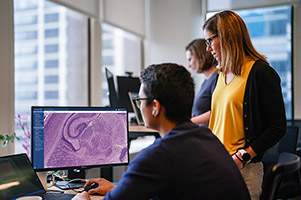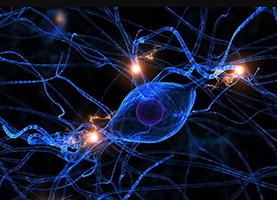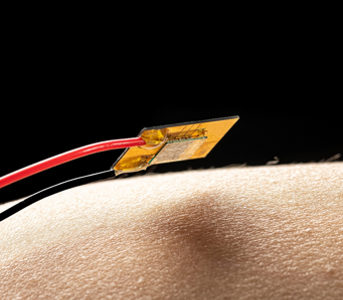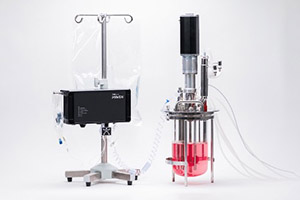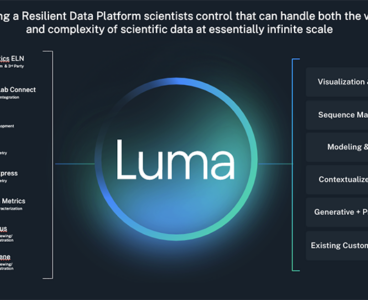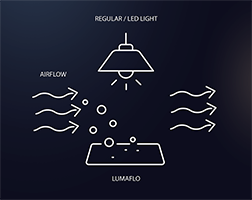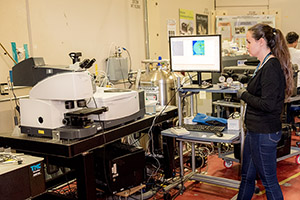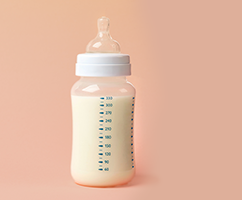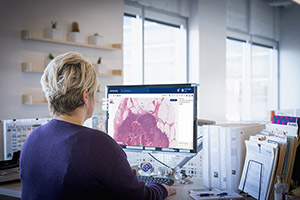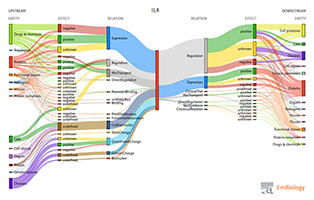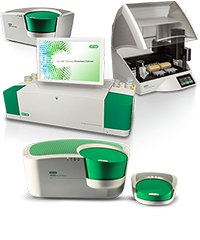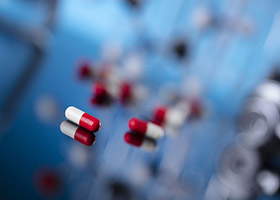QDx Pathology Services, an independent anatomical, molecular, and clinical pathology laboratory serving medical professionals and facilities throughout the U.S., is working with Proscia, a provider of digital and computational pathology solutions, to innovate its practice. The laboratory has deployed Proscia’s software to enable its pathologists to work faster and more confidently. Digital pathology is modernizing…
Pramana joins Proscia to help laboratories realize more value from their pathology data
Proscia, a provider of digital and computational pathology solutions, announces that , an AI-enabled health tech company modernizing the pathology sector, is now a Proscia Ready partner. Pramana joins the partner alliance to help life sciences organizations and diagnostic laboratories leverage enriched, high-quality data, including DICOM images, in their routine research and clinical operations. Proscia Ready…
Overcoming the machine learning paradox: How the Allen Institute is scaling its computational research
Despite the buzz surrounding AI in the past decade, its implementation within scientific research organizations isn’t as pervasive as one might think. One of the reasons for this is that research organizations often face a staffing dilemma when it comes to managing large-scale computational research and computational analysis. Historically, most research organizations have employed scientists…
ABB Robotics joins XtalPi to build intelligent automated laboratories
ABB Robotics and XtalPi have entered a strategic partnership to produce a range of automated laboratory workstations in China. The new, automated laboratories will boost the productivity of R&D processes in biopharmaceuticals, chemical engineering and chemistry, and new energy materials. “Our collaboration with XtalPi marks another milestone for ABB’s collaborative robots in the life sciences…
SpaceX returns vital life science research sponsored by the ISS National Lab
Dozens of science and technology development payloads returned to Earth from the International Space Station (ISS) on December 22 as SpaceX’s 29th Commercial Resupply Services (CRS) mission, contracted by NASA, successfully concluded. More than 30 payloads sponsored by the ISS National Laboratory returned on this mission, many of which were life science investigations aimed at…
Centricity Research acquires North Carolina-based Lucas Research
Centricity Research, one of North America’s largest clinical research networks with headquarters in Columbus, Georgia, and Toronto, has announced that it has acquired Morehead City, North Carolina-based Lucas Research, extending the organization’s reach and capabilities. Operating five research sites in North Carolina — in Morehead City, New Bern, and Hickory — Lucas Research is the fifth…
Wearable Thin-Film Thermoelectric Cooling Device (TFTEC) for prosthetics and haptics is R&D 100 winner of the day
State-of-the-art prosthetic limbs that can restore near-natural hand and arm control for people living with the loss of limb and limb differences have long been the dream of researchers. Researchers at The Johns Hopkins APL have developed the wearable thin-film thermoelectric cooling (TFTEC) device, one of the world’s lightest, thinnest, and fastest refrigeration devices. The…
MAVEN, online glucose and lactate-monitoring device, is R&D 100 winner of the day
908 Devices is developing devices for scientists to enhance their process understanding and accelerate workflows. For cell culture and fermentation processes, the company’s online MAVEN device precisely measures glucose and lactate while preserving sample integrity. It eliminates manual sampling from a bioreactor with its novel aseptic sampling approach, which saves operator time, reduces contamination risk,…
Proscia achieves ISO 27001 security certification
Proscia, a provider of digital and computational pathology solutions, has earned ISO 27001 certification. This certification demonstrates the company’s compliance with one of the best-known information security management standards, giving customers added confidence in its products. ISO 27001 sets forth requirements for establishing, implementing, maintaining, and continually improving an information security management system (ISMS). Comprehensive…
New Dotmatics Luma scientific data platform helps enable AI and ML in life sciences
Dotmatics, an R&D scientific software company connecting science, data, and decision-making, announces the launch of Dotmatics Luma, a revolutionary new scientific data platform that helps scientists and administrators in life sciences unify and analyze large volumes of data for better decision-making. Luma provides customers an out-of-the-box, low-code SaaS platform that flexibly aggregates all relevant data…
DoMore Diagnostics and Proscia partner to inform personalized treatment decisions for colorectal cancer patients
DoMore Diagnostics, a company specializing in deep learning precision diagnostic for digital pathology, and Proscia, a provider of digital and computational pathology solutions, have partnered to help pathologists predict outcomes for colorectal cancer (CRC) patients. The collaboration paves the way for integrating artificial intelligence (AI)-powered clinical decision support into routine pathology workflows, unlocking new insights…
R&D 100 winner of the day: Siemens Healthineers Intelligent Emergency Imaging
Patient-centered innovation has been and always will be at the core of Siemens Healthineers, whose employees constantly bring breakthrough innovations to market to help healthcare professionals deliver high-quality care and achieve the best possible outcome for patients worldwide. The Siemens Healthineers Intelligent Emergency Imaging workflow powered by myExam Companion helps speed up the care pathway…
Novel nanomaterial air purification beats HEPA at filtering contaminants and pathogens
LumaFlo, a technology company developing highly potent and cost-effective air decontamination systems, announces a breakthrough solution that uses a proprietary modified carbon-based nanostructured material that can be applied to ordinary surfaces, and — in the presence of daylight or LED light — inactivates bacteria or pathogens spread by air. Air filters and ultraviolet light are…
R&D 100 winner of the day: Spectral Phenotyping with MirroRx
Lawrence Berkeley National Laboratory’s MirroRx is a biomarker technology that accurately predicts disease status. The disease phenotype is analyzed by measuring how the patient’s endogenous molecules vibrate upon exposure to infrared light. The difference between the vibrational profiles of disease and control samples is so visible that the spectral process is like “cellular fingerprinting.” Aggressive…
JEOL installs two cryo-electron microscopes at Generate:Biomedicines to capture atomic resolutions
Two towering JEOL Electron Microscopes stand ready to produce terabytes of valuable data for researchers at Generate:Biomedicines each day, who are accelerating drug discovery and development of novel therapeutics using machine learning and generative artificial intelligence. The two Transmission Electron Microscopes, the JEOL CRYO ARM 200 and CRYO ARM 300 are used in structural biology,…
Genomenon acquires Boston Genetics to accelerate curation of human genome
Genomenon Inc., a Genomic Intelligence company, announces it has acquired Boston Genetics, a genomics interpretation and curation company. By combining Genomenon’s unrivaled AI-powered platform for genomic knowledge and tech-enabled scientific expertise with Boston Genetics’ substantial team of genetic scientists, Genomenon is now in the lead position to be the first company to curate the entire…
BBy creates first condensed-to-powder breast milk, announces seed funding
BBy, a healthtech company revolutionizing hospitals’ breast milk storage and administration process, introduces its food device that condenses breast milk to a powder, maintaining the crucial bioactive components that make breast milk the best infant nutrition. BBy is disrupting a 70-year-old process in which hospitals have stored and administered donor breast milk in freezers, wasting…
Thermo Fisher Scientific expands steriles manufacturing and research capabilities in Asia-Pacific region
Thermo Fisher Scientific has opened a new sterile drug facility in Singapore that will better enable customers to deliver new medicines and vaccines in the Asia-Pacific market. The new facility also marks a significant milestone and investment in pandemic preparedness for Singapore, which is fast emerging as a biomedical hub in the Asia-Pacific region. Established…
RotaChrom rCPC platform adheres to CGMP guidelines for pharmaceuticals
RotaChrom has announced its rCPC platform conforms to Current Good Manufacturing Practices (cGMP) for the pharmaceutical industry, allowing the use of its rCPC purification and separation systems within cGMP-compliant laboratory and manufacturing environments. ”The GMP rCPC is a preparative purification platform that we specifically designed for the highly regulated pharmaceutical GMP environment,” said Andras Gaspar,…
Cloud-based digital pathology platform helps CRO deliver more informed preclinical studies
Proscia, a provider of digital and computational pathology solutions, has announced that Virscio, a provider of translational research and development services, has deployed Concentriq for Research. The contract research organization (CRO) is leveraging Proscia’s flagship software platform to provide faster, more informed drug safety insights, helping its sponsors to improve research and development (R&D) efficiency.…
EmBiology delivers insights into biological activities that accelerate drug discovery
Elsevier, a global information analytics company, has launched EmBiology, a research tool that visualizes a comprehensive landscape of biological relationships, empowering researchers to gain a rapid understanding of disease biology and focus on critical evidence. Powered by Elsevier’s Biology Knowledge Graph, EmBiology draws on a broad and deep database of multiple sources, including over 7.2…
Bio-Rad’s digital PCR System advancing measurable residual disease research
Bio-Rad Laboratories, a company specializing in life science research and clinical diagnostic products, is accelerating measurable residual disease (MRD) research through more than a half dozen collaborations with institutions and companies leveraging its new QX600 Droplet Digital PCR System. Launched late last year, it boasts six color detectors capable of quantifying 12 targets per well,…
Thermo Fisher Scientific opens facility at UCSF to accelerate development of breakthrough therapies
Thermo Fisher Scientific and the University of California, San Francisco (UCSF), will accelerate advanced cell therapies for difficult-to-treat conditions, including cancer, rare diseases, and other illnesses, from a newly opened cGMP manufacturing facility adjacent to UCSF Medical Center’s Mission Bay campus. The partnership between Thermo Fisher and UCSF, first announced in 2021, has the potential to demonstrate…
Proscia announces expansion in preclinical R&D to drive faster drug safety decisions
Proscia, a provider of digital and computational pathology solutions, has strengthened its position in the $12 billion[1] preclinical R&D market. At the center of its expansion, the company is enhancing its flagship Concentriq for Research, trusted by 14 of the top 20 pharmaceutical companies as a singular software platform for pathology workflows and data, to…
New qPCR master mixes help shorten path from discovery to commercialization of final assay
Applied Biosystems has introduced the TaqMan 2.5X Lyo-Ready 1-step qPCR Master Mix with an excipient, an optimized, ready-to-use formulation to be incorporated into a lyophilization process. All lots are functionally tested to help ensure lot-to-lot reproducibility. This reagent is manufactured in an ISO 13485-certified facility to a high level of quality standards. Lyophilization guidelines provided…


